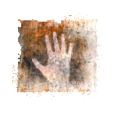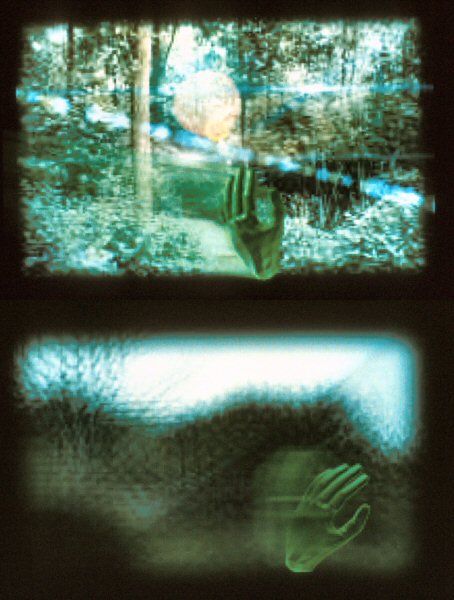Alan Dunning
(Calgary, Alberta, Canada)
Billy Budd's Stammer (1988), inspired by Herman Melville's novel of the same name and presented at the Walter Phillips Gallery (Banff, Alberta), comprised a collection of random images within a grid whose framework underlined the process of mechanical duplication. An architectural component (a chain-link fence), evoking the gallery space, set up a sort of ambulatory all along the walls, giving visitors the perspectives of panorama and close-up.
A 384-page book containing the full collection of images accompanied the exhibition. (1) Using a hybrid publication (neither artist book nor exhibition catalogue) to complement an installation is common for Dunning. Mother (1990) revealed the semiotic differences produced when the same content is presented in different contexts. On the gallery walls, words were linked by lines as in a constellation or rhizome. In book form, however, the same text is set up linearly in a highly ornamental Gothic typeface. Another work, Translation (1991), further analyzed multiple occurrences of the same series of signs. A stain found on the original of a manuscript once translated by Dunning's mother is enlarged disproportionately. (2) This work highlights the analogy between the translation of a text from one language to another, the transmission of information from the author to the reader, and the migration of this text toward a new medium.
Dunning's wall installation projects contain patterns that can repeat exponentially depending on the surface on which they are shown. As his personal goal is often to use all the space allotted to him, the artist must undertake considerable manual labour whose material results become in a way the yardstick of his success. (3)
This was certainly true in Elision (1991) presented at the Contemporary Art Gallery (Vancouver, British Columbia), an installation that, according to the artist, represented a veritable architecture of labour. Elision consisted of 2,000 individual letters on Mylar that were pinned on the wall to cover the gallery's entire surface. The series of artist books accompanying the installation (The Sick Bed, The Body of the Astronaut, Susie Clelland) bring together stories of alienation and subjection that seem to echo the colossal work invested in hanging the letters in the installation.
In his book works, elements taken from different sources and linked by their content form ensembles that verge on inventories, and their great number sometimes exhausts the possibilities for using a whole family of utterances. Chevaux de frise (1991) is one such project. Containing excerpts from 66 detective novels by the genre's leading lights (Agatha Christie, Martha Grimes, P. D. James and Ruth Rendell), this textual patchwork reduces the genre to its formal conventions while spotlighting its cliché vernacular.
To create Ville de lumière/City of Light, which was exhibited at the National Gallery of Canada (1994), Dunning gathered descriptions of urban locations from canonical texts of the nouveau roman and from movie summaries from TV guides, which he then structured using a database. Visitors entering the huge site exhibiting this text underwent a reading experience similar to the urban "dérives" theorized by Guy Debord. (4) It was impossible to read the statements linearly. Visual beacons on the wall surfaces enabled visitors to map this virtual city using eclectic fragments in the manner of situationist psychogeography. A large photograph completed the installation, presenting the image of a bourgeois interior in which certain details were shown and others left in shadow. Like the text, this photograph was a composite image made up of many iconographic sources fused together with help from image processing software.
In 1994, Dunning dispensed with this type of monumental installation and devoted himself to in-depth research on immersive environments in which virtual reality wasn't always in the foreground. Such was the case for Rapture/Scattered Bodies (1995), (5) an installation presented at the gallery Optica (Montreal, Canada) in 1996 in which the immersive experience was represented by an allegorical detour rather than proposed literally. The image of a deep-sea diver appeared on a screen, while the amplified sound of his breathing was played in the room. Deep-sea diving conjured up an extreme experience testing the boundaries between interior and exterior. Dunning investigated the rapture of the deep felt by the diver, the desire to break out of the confines of both his ego and his diving gear. In addition to the diver's paradoxical immersive experience, the installation included images of scent molecules that covered the gallery walls and evoked smell as a sense encouraging a merging with the world more than a distancing of the object and the subject.
The cycle of installations in The Einstein's Brain Project (1995-2001) is a major technological detour for Dunning that, nonetheless, re-examines his past conceptual concerns. In this long-term project begun in 1995 with Paul Woodrow and a team of scientists from different fields, Dunning probes the new epistemological models that have developed thanks to technological advances in virtual reality. (6)
The artificial worlds summoned up by the immersive universes often rekindle the presuppositions of a naturalistic project whose aim is to simulate familiar experiences. The interfaces created by Dunning and Woodrow propose a critical counterbalance to the withdrawal to the Cartesian universe. In the wake of recent research in cognitive science, the two men are interested in how biological and brain processes shape our perception of the world.
An initial series of installations completed between 1997 and 2001 explored popular culture's fascination with the human brain. Evidence of this fascination is found in Roland Barthes's essay on the fetishism of Einstein's brain, a reflection that serves as a critical point of reference for the installations in this body of work. By reactivating obsolete systems of representation (phrenology, eugenics, etc.), this series also underlines the impact of pseudo-scientific projections on our knowledge of the body and psyche.
In The Fall, The Furnace, The Flesh (1997), (7) participants underwent a sort of ritual as they crossed through a curtain made up of thin vinyl strips. These strips served as a screen for projecting an image of a blazing fire. Participants found themselves in a cubic space defined by four screens. In the middle of the space was an anatomically correct model of the human head covered with touch-sensitive pads (audio-digital). The location of the 55 pads replicated the brain map developed by the phrenologists Franz Joseph Gall and Johann Spurzheim. In the Victorian age, studying the skull's contours over these zones supposedly revealed a person's character traits and psychological predispositions. Dunning recycled the paradigm of phrenology as a means of accessing the installation's touch-sensitive interface. As participants pressed the pads, a series of video segments were projected on the wall. These segments, which came from various sources, showed irreconcilable objects and events that evoked the series of random associations produced by the brain as it assembles fragments of stored memory. Here, the unconscious content could not easily be distinguished from fragments of images from the media sphere. Images appeared erratically: a lunar eclipse, close-ups of the body, a political demonstration, a hall in a museum, a text flashing at a dizzying speed, barely perceptible abstract images. With the combination of images almost infinite, the screen constantly offered new sequences of juxtaposed images.
The virtual environment installations The Errant Eye (1997-2001) and The Madhouse (2001) delved into Dunning and Woodrow's premise that the image captured on the retina doesn't always converge with brain activity. In The Errant Eye, the biological data gathered in real time on the participant's body altered the display parameters of a three-dimensional virtual universe. The participant donned a head-mounted display equipped with encephalogram electrodes that recorded the changing amplitude of brainwaves from the brain's right and left sides. The participant then navigated around a recognizable visual environment, a forest whose outline faded into an abstract visual universe reflecting the variations in biological signals processed in real time by a computer module. Once the feedback process reached the balance sought, the participant could recognize recurring motifs that corresponded to certain types of reactions and perceptions.
The Madhouse (2001), which was presented at the gallery Oboro (Montreal, Canada) in 2001, allowed participants to pool their individual perceptions as they experimented simultaneously with feedback. A luminous life-size cast of the human body lay in the centre of a room and was surrounded by participants in an immersive state. The participants touched the surface of the body, which stored and displayed their handprints and fingerprints as if the body's material presence were providing them with a kind of anchorage in the physical world. Behind their displays, the participants were catapulted into a virtual world, while viewers on the periphery could observe their erratic gestures, which resembled the spasms of mental patients (hence the work's title). Through this sharing of the immersive experience, which is often deemed autarchic, Dunning and Woodrow's project created a more complex model of a virtual community that didn't exclude the body of the participants.
A series of installations in development will further explore technological and conceptual aspects begun within The Einstein's Brain Project. Under the working title (WIW), Worlds in Worlds, Dunning plans to put together an immersive environment whose boundaries will be defined by the real dimensions of the room the participant is in. Dunning is also interested in the Anatomically Lifelike Biological Interface, which operates via a model reproducing certain bio-anatomical functions. In this vein, he is pursing research on the properties of ferrofluids, liquid matter that can be altered by an electromagnetic field and modified by biological signals from the human body.
Vincent Bonin © 2002 FDL
(1) See Alan Dunning, Billy Budd's stammer: The Structure of the New Defense, Banff, Walter Phillips Gallery, [1988?], [384 p.].
(2) In the brochure accompanying the exhibition of Translation at the Glenbow Museum (Calgary, Alberta) in 1991, Dunning discusses his interest in mediation processes and the people implicated such as translators and interpreters. See Translation, Glenbow Museum, Calgary, 1991, [2] p.
(3) In an interview published by Rhizome, Dunning explains this notion of labour. See Advicebunny: Interview with Alan Dunning, Rhizome.org, (accessed May 31, 2001): http://www.rhizome.org/object.rhiz?1920
(4) Le concept de dérive est souvent employé par Dunning qui se l'appropriera entre autres pour qualifier l'expérience d'immersion en réalité virtuelle.
(5) A CD-ROM version of the work accompanied the exhibition at the gallery Optica (Montreal, Canada).
(6) See the site documenting the works that make up this opus: http://www.ucalgary.ca/~einbrain/ebessay.htm
(7) This cycle, exhibited under the titles The Furnace/The Flesh (1997) and The Crucible (2001), was presented internationally within such events as the Alberta Biennale (Alberta, Canada) in 1998 and the Seventh New York Digital Salon at the Visual Arts Museum (New York, New York) in 1999.
Related pages:
 Alan Dunning, Representations of the Body in Liquid Media Spaces
Alan Dunning, Representations of the Body in Liquid Media SpacesA collaborative effort with leading scientists, the Einstein Brain Project comprises a series of immersive environments.
 Caroline Langill, Shifting Polarities, Interview with Alan Dunning
Caroline Langill, Shifting Polarities, Interview with Alan DunningAlan Dunning arrived from the United Kingdom to Calgary (Alberta) in 1979.
















